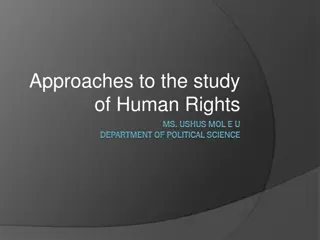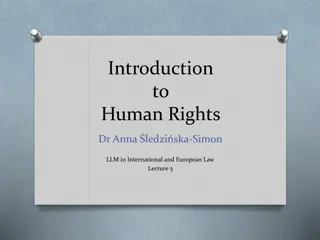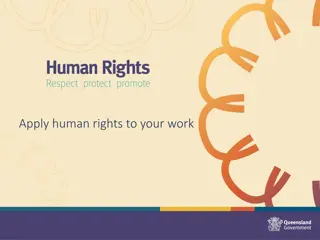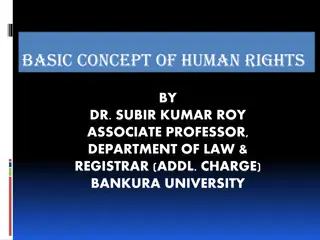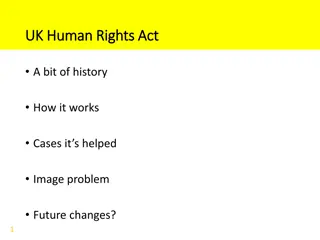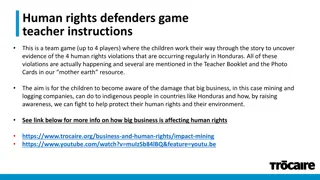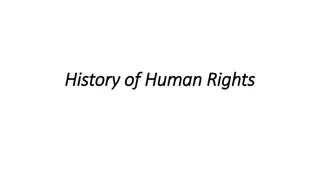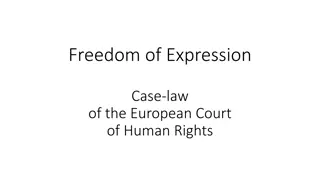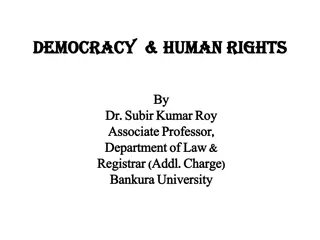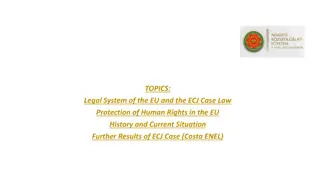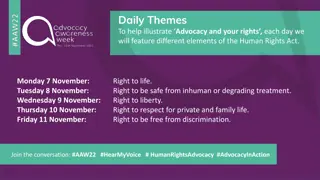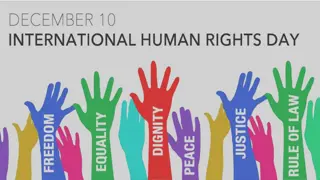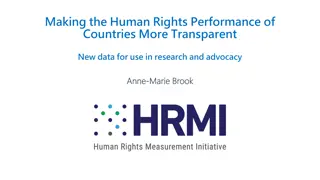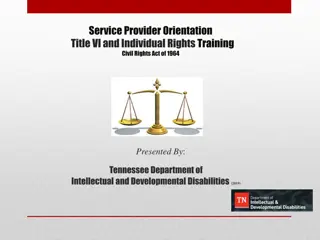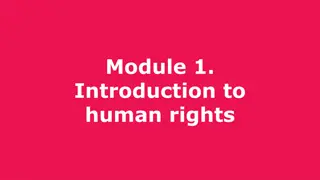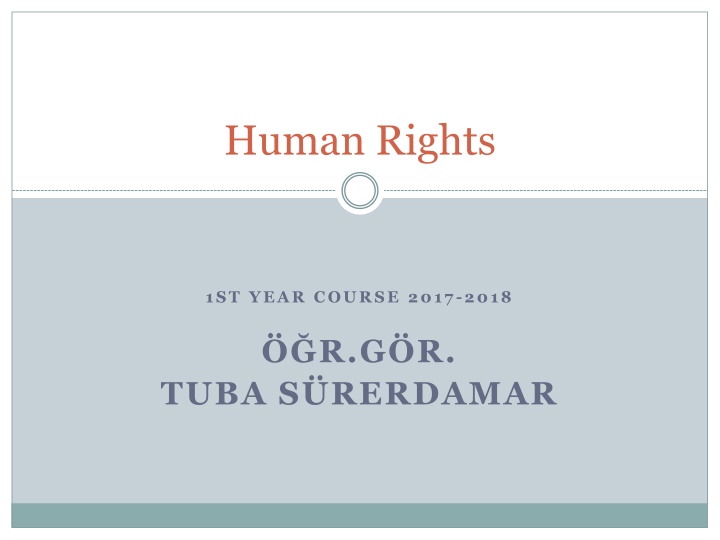
Human Rights: First Year Course Overview 2017-2018
Tuba S. Rerdamar shares her educational background, work experiences, and semester overview of a Human Rights course for the academic year 2017-2018. The content outlines the expectations of students, semester structure, and key topics covered in the course. It also includes a bibliography of essential resources on Universal Human Rights and International Human Rights Law.
Uploaded on | 0 Views
Download Presentation

Please find below an Image/Link to download the presentation.
The content on the website is provided AS IS for your information and personal use only. It may not be sold, licensed, or shared on other websites without obtaining consent from the author. If you encounter any issues during the download, it is possible that the publisher has removed the file from their server.
You are allowed to download the files provided on this website for personal or commercial use, subject to the condition that they are used lawfully. All files are the property of their respective owners.
The content on the website is provided AS IS for your information and personal use only. It may not be sold, licensed, or shared on other websites without obtaining consent from the author.
E N D
Presentation Transcript
Human Rights 1ST YEAR COURSE 2017-2018 R.G R. TUBA S RERDAMAR
WHO AM I? Tuba S rerdamar 31.01.1986 Aalst/Belgium Married 1 son EDUCAT ON: College: Sint-Maarteninstituut Aalst/Belgium Bachelor Degree in Law: Catholic University of Leuven /Belgium
WORK EXPER ENCES: CATHOL C UN VERS TY OF LEUVEN EU M N STRY OF TURKEY (ANKARA) DEA CONSULT BRUSSELS LAWFIRMS: *Advocatenassociatie Van Aelst- Gauquie-Van der Straeten *Advocatenkantoor Aalst OSMAN YE CHAMBER OF COMMERCE AND NDUSTRY WORLDDANI MANLIK Master Degree in Law: Catholic University of Leuven /Belgium MAJOR: nternational and European Law M NOR: Economic and Trade Law THES S: Human Rights Law: The discriminatory educational system towards the Arab minority in srael
NTRODUCTON What do students expect from the HR-course? - Teoritical classes memorizing everything - Practical classes - Actuality discussions (newspapers) - Presentations - From students
SEMESTER OVERVEW (1) Week 1: ntroduction Week 2: Historical development, Concept and definition of HR Week 3: Characteristics of HR Week 4: Classification of HR Week 5: Place and Major Subjects of HR Week 6: Sources of HR (1) M DTERM EXAM NAT ON WEEK
SEMESTER OVERVEW (2) Week 7: Sources of HR (2) Week 8: Restrictions of HR (1) Week 9: Restrictions of HR (2) Week 10: Protection of HR - NT Week 11: Protection of HR - NT Week 12: Protection of HR EU F NAL EXAM NAT ON WEEK
BBLOGRAPHY Jack DONNELLY, Universal Human Rights in Theory and Practice, Cornell University Press, America, 2013. Dinah Shelton, The Oxford handbook of international human rights law, Oxford University Press, Oxford, 2015. Daniel Moeckli, Sangeeta Shah, Sandesh Sivakumaran, International human rights law, Oxford University Press, Oxford, 2014, 2nd ed. Durmu TEZCAN, Mustafa Ruhun ERDEM, O uz SANCAKDAR, R fat Murat NOK, nsan Haklar El Kitab , 4 ed., Se k n Yay nc l k, Ankara, 2011. Halil KALABALIK, nsan Haklar Hukuku, Se kin Yay nc l k, Ankara, ekim 2015. Kemal G ZLER, nsan Haklar Hukukuna Giri , Ekin Bas m Yay n Da itim, Bursa, temmuz 2017. Ebru KARAMAN, Human Rights Law, on iki levha yay nc l k, stanbul, eyl l 2014.
NTRODUCTON CASE STUDY PROTECTING CHILD SOLDIERS IN THE DEMOCRATIC REPUBLIC OF CONGO https://www.youtube.com/watch?v=FIWIQ4Wt4o8 In the Democratic Republic of Congo (DRC) children make up the majority of combatants in the civil war and prolonged fighting between militia groups that has claimed over five million lives since 1997. In the eastern Democratic Republic of Congo, children as young as six are routinely recruited by militias and taught to kill. It is estimated that 8- to 16-year-old-children make up 60% of combatants in the region. A Duty to Protect tells the story of January and Mafille, two girls recruited into the military at ages ten and thirteen. Mafille is a demobilized soldier whose experience of violence and sexual exploitation caused her deep emotional scars. January is a young, soldier whose bravado veils her suffering, and whose character and perceptions personify the complexity of the conflict and the views of the local population.
This video also looks at the effects of the recruitment and use of child soldiers on their families and the broader community. The video features powerful footage, shot between 2003 and 2004, of children receiving military training in several militia camps in South Kivu along with compelling testimony from demobilized child soldiers. At the time of filming, more than 10 militia groups operated in the region. All were reportedly using child soldiers. Over 35% of these children were recruited voluntarily, many motivated by a sense of patriotism or poverty. Parents and the community at large are also often involved in this voluntary recruitment of children. On the Frontlines has been screened throughout communities in Eastern DRC in an attempt to cease the voluntary recruitment of children from these communities.
The video feature s voices of child soldiers and explore the complexity of the war, the issues confronted by female child soldiers such as rape and sexual exploitation, and the importance of the International Criminal Court (ICC) to end the rampant impunity reigning in the eastern DRC. A Duty to Protect gives specific recommendations to strengthen the work of the ICC and calls for the international community s engagement to stop the recruitment and use of child soldiers. On January 26, 2009, the ICC began its first trial a landmark case against Congolese warlord Thomas Lubanga Dyilo. Lubanga stood accused of conscripting and enlisting children under the age of 15 to fight in his militia between 2002 and 2003 during the Congolese civil war. On March 14 2009, the International Criminal Court found Thomas Lubanga guilty of the war crime of using children in armed conflict.
HUMAN RIGHTS H STOR CAL DEVELOPMENT
HSTORCAL DEVELOPMENT (1) ntroduction video: https://www.youtube.com/watch?v=6XXGF_V8_7M HR are not born on an exact date but are rather gained after a long long long struggle of mankind. Starting principle of HR-writers turn back to early religious and philisophical writings to study the exact meaning of HR: human beings are endowed, by reason of their humanity, with certain funfamental and inalienable rights Has existed in various forms in various societies s associated with the evolution of Western philosophical and political principles Hammurabi s Code in ancient Babylon (arround 1780 BC): recognition of the need to protect human freedom and human dignity Confucian, Hindu or Buddhist tradions have created a first atmosphere to think about others well- being Religious texts such as the Bible and the Koran can be read as creating not only duties but also rights
HSTORCAL DEVELOPMENT (2) The Rise of HR-ideas during different times in history: A) Religion B) Philosophy C) The Middle Ages, The Reformation And The Enlightenment D) World War II
A) The first emergence of the HR-principles through REL G ON (1) 4500 years ago: H NDU SM ( ndia) All human life is sacred and should therefore be treated with an immutable respect and love. 3300 years ago: JUDA SM ( srael) Speaks of the value and sacredness of all God s children, but also of the responsibility that human beings have towards each other. 2500 years ago: BUDDH SM ( ndia) s based on the universal issues of human relationships, respect for the life of each person and compassion in the face of pain suffered by fellow human beings. 2500 years ago: CONFUC AN SM (China) The manifestation of the best in humans, extending beyond the personal in its capacity to care for others: If there is righteousness in the heart, there will be beauty in the character. If there is beauty in the character, there will be harmony in the home.
A) The first emergence of the HR-principles through REL G ON (2) If there is harmony in the home, there will be order in the nations. When there is order in the nations, there will peace in the world. 2000 years ago: CHR ST AN TY (Jerusalem) Jesus repeatedly spoke of the need to take care of the poor, the sick and the hungry, and the necessity of welcoming strangers. 1500 years ago: SLAM (Mekkah) The prophet Muhammed: preached in favour of an absolute equality among races and that religious toleration should be guaranteed. The Koran: adresses the sanctity of life, compassion and obligation to one s fellow human beings. All men are equal in the eyes of Allah: freedom from injustices perpetuated by social privilege.
B) The raise of the HR-principles through PH LOSOPHY (1) ANC ENT CH NA (2400 years ago): Mo Zi, the founder of Mohist school of moral philosophy: importance of duty, self-sacrifice and an all-embracing rescpect towards all others, not only friends and family, but the whole world. ANC ENT BABYLON: King Hammurabi Code Hammurabi : one of the first written laws in history, based on broad principles of justice among people. t sought to give the oppressed man equal protection under the law. ACHAEMEN D PERS AN EMP RE (2600 years ago): Cyrus the Great Charter of Cyrus (Cyrus cylinder): recognized certain rights such as liberty, freedom of religion, economic and social rights Cylinder is also called the first declaration of HR in history
B) The raise of the HR-principles through PH LOSOPHY (2) ANC ENT GREECE (2300 years ago): A notion of universal law of nature of god (Natual law) is developed. This law governed the universe in all facets and gave a basis for egalitarian society founden on respect for citizens and for equality. Human did not have any value. A person was either a member of the city, or was on his own. * Aristo and Plato: defended people being unequal and accepted the slavery institution ! * mpossible to talk about HR during this period. ROMAN STO CS NATURAL LAW: broadened the scope of rights to include more beneficiaries than in the Greek tradition. *Cicero: developed a theory of universal justice that guided human nature to act justly and be of service to others; claimed that the natural law binds all human society together. * IUS GENT UM developed by Roman jurists
C) HR during the MDDLE AGES, the REFORMAT ON and the ENL GHTENMENT(1) T LL NOW: always focus on universal responsibilities and duties, rahther than on what we now know as HR Took centuriesof fighting to pave the way for concepts of natural rights to emerge The decline of feudalism gave rise to a middle class with economic and political power The Renaissance and the Reformation liberated the individual from prior spiritual constraints and religious intolerance and citizenry became increasingly critical for tyrannical leaders M DDLE AGE PER OD: the emergence of Christianity and feudalism are important in terms of human rights. Freedom = freedom of feudal lords on their lands = people s service and loyalty against their rulers and the protection the rulers are giving to the people MAGNA CARTA GREAT BR TA N: the first document to reflect the importance of HR t constitutes a basic for the idea of limiting the political regime for the firs time. However there was no significant development on the area of HR until the age of enlightment
C) HR during the MDDLE AGES, the REFORMAT ON and the ENL GHTENMENT(2) THOMAS AQU NAS - (13th century): important philosopher with focus on ethics and theories of natural law and politics human: to live out of a sense of justice towards others was to live divinely Supporting the principle that every person is an individual apart from membership in a particular state ENL GHTENMENT: a shift in view from natural law as duties to natural law as rights JOHN LOCKE (England 17th century): attempted to weave universal natural law and natural rights together Argues that every human being in the state of nature possesses certain natural rights People are born in a perfect state fo equality, where naturally there is no superiority or jurisdiction of one over another.
C) HR during the MDDLE AGES, the REFORMAT ON and the ENL GHTENMENT (3) JEAN-JACQUES ROUSSEAU (France): man is born free Espoused the use of human reason and knowledge to free individuals from dogma and absolute authority Reform and renaissance movements in the 16th century + humanism movements changed the expectations of a person from government: 1627: Petition of Rights 1679: Habeas Corpus Act 1689: Bill of Rights after revolution in England in 1688 All these declarations are important developments: are including jurisdiction assurances and assurances against arbitrary arresting Bill of Rights: much more important because it first important development in Europe with regards to the penetration of HR into positive law.
C) HR during the MDDLE AGES, the REFORMAT ON and the ENL GHTENMENT (4) 1776: Virginia Declaration of Rights (USA) Declaration of ndependence (from Britain) First regulation that contains HR on constitutional level: rights of individual against the authaurity were expressly accepted: Starts with: We hold these truths to be self-evident, that all men are created equal, that they are endowed by their Creator with certain unalienable rights, that amonng these are life, liberty and the pursuit of happiness. 1789: Declaration of Human and Citizen Rights (France) - NATURAL R GHTS After French Revolution Mostly influenced by the English revolution (17th Century) and the American revolution (18th Century) Starts with: people are born free and equal in rights
C) HR during the MDDLE AGES, the REFORMAT ON and the ENL GHTENMENT (5)
D) HR after WORLD WAR II (1) No significant development on HR before WWII Millions of dead people feeling that no one has rights at all disbelief of people in HR Paul Gordon Lauren: World War II was a test for values and ideas as well as for weapons and warriors. t exposed, as nothing else had ever been able to do, the ultimate consequences of allowing nations to hide behind the shield of national sovereignity and claims of exclusive domestic jurisdiction. Revolution on behalf of HR: accepting value and importance of human and HR Placed the issue of HR high on the global agenda United Nations CHARTER 26 June 1945 (San Francisco) Political document establishing a political institution: the United Nations Also a philosophical, historical, moral and legal document setting forth a vision of a future world
D) HR after WORLD WAR II (2) WE THE PEOPLES OF THE UNITED NATIONS DETERMINED to save succeeding generations from the scourge of war, which twice in our lifetime has brought untold sorrow to mankind, and to reaffirm faith in fundamental human rights, in the dignity and worth of the human person, in the equal rights of men and women and of nations large and small, and to establish conditions under which justice and respect for the obligations arising from treaties and other sources of international law can be maintained, and to promote social progress and better standards of life in larger freedom, AND FOR THESE ENDS to practice tolerance and live together in peace with one another as good neighbours, and to unite our strength to maintain international peace and security, and to ensure, by the acceptance of principles and the institution of methods, that armed force shall not be used, save in the common interest, and to employ international machinery for the promotion of the economic and social advancement of all peoples, HAVE RESOLVED TO COMBINE OUR EFFORTS TO ACCOMPLISH THESE AIMS Accordingly, our respective Governments, through representatives assembled in the city of San Francisco, who have exhibited their full powers found to be in good and due form, have agreed to the present Charter of the United Nations and do hereby establish an international organization to be known as the United Nations.
D) HR after WORLD WAR II (3) UN VERSAL DECLARAT ON OF HUMAN R GHTS (UDHR) - 10 december 1948: Have taken an almost mythical importance Positive: the document is seen by the governments and peoples as a document for guidance inspiration for similar international agreements (in and out the EU) F.e. The European Convention on HumanRights (ECHR) Negative: is treated MORE inspirational than real = not what the drafters intended more aggressive approach to HR Majority of the Rights placed on UDHR has been recognized in the further agreements Some of them have gained the qualification of custom rules in time UN TED NAT ONS INTERNAT ONAL COVENANT ON C V L AND POL T CAL R GHTS 1966 Regulates rights that are mostly placed under the UDHR in a way more concrete and comprehensively
HUMAN RIGHTS CONCEPT AND DEF N T ON
DEFNTON of HR (1) The most popular known definition of HR: people s rights arising from being a human Commonly understood as being those rights which are inherent in the mere fact of being human Based on the belief that every human being is entitled to enjoy these rights without discrimination (race, religion, nationality, gender, economy, social or political status does not matter) Law order merely recognizes the individual as owner of the right Applies on all humans HUMAN: means real persons Ownership of rights begins with acquisition of the individuality ndividualty starts with birth and ends with death mportant issue: protecting HR for the child in the womb of the mother before birth Legal persons (associations, companies, foundations, ) do not benefit directly fron the HR Regulations Benefit in certain limits and in scale according to their natures
DEFNTON of HR (2) R GHT: Freedom that is provided to be benefited by community, it is recognized, and its limits, subjects, methods and conditions of use are indicated by law n other words: an authorization that is granted by law to persons HR have no definition that is constant and commonly accepted by everyone The Majority of these rights coincide with the natural rights arising from the human nature F.e. Right to live
CONCEPT of HR (1) The fight for HR has been a long process, the same for the concept of HR n the past: Natural Law , Natural Rights The use of Human Rights is very new : WWII The concept of HR has won popularity after WWII Eleanor ROOSEVELT used it frequently during her carrier at the UN Concepts directly related to HR are used in different meanings in the doctrine and HR documents we shall define these concepts such as Natural Law/Rights, Positive Law, Right and Duties, Human Dignity and Fundamental Rights.
CONCEPT of HR (2) Natural Law Natural Rights: The unwritten body of universal moral principles that underlie the ethical and legal norms by which human conduct is sometimes evaluated and governed Derived from the Roman period (jus naturale) Naturalists believe that: natural law principles are inherent to nature and exist regardless of whether government recognizes or enforces them Governments must incorporate natural law into their legal systems before justice can achieved Positive Law: Consists of the written rules and regulations enacted by government = man-made law
CONCEPT of HR (3) Rights: is an expectation about something you deserve or a way to act that is justified through a legal or moral foundation Things to which you are entitled or allowed Freedoms that are guaranteed Types: legal, moral, spiriual, natural, fundamental, Duties: A direct result of the acceptance of rights Every person has a duty to uphold or respect another person s right, just as that person has the duty to uphold your rights Human Dignity (insan onuru): Expressed as human pride Based on the understanding in which human is the most precious entity Open ended concept not possible to define clearly Has an absolute and universal nature + important ethical value All rules that secure human dignity are included in the scope of HR Used frequently in international documents such as UDHR and the ECHR
CONCEPT of HR (4) Public Rights (kamu h rriyetleri): are generally granted to individuals in their relationship with the government May only be used against the government Difference with HR = absolute rights Can be used against anyone Majority of fundamental rights = public rights that are regulated by the constitution Liberties (h rriyetler): n other words: freedoms Narrow meaning (ECHR and Turkish Constitution): freedom of moving freely Wider meaning (French Declaration 1789): eveything that is not prohibited by law = unregulated freedom Compared to rights : more abstract and unclear

